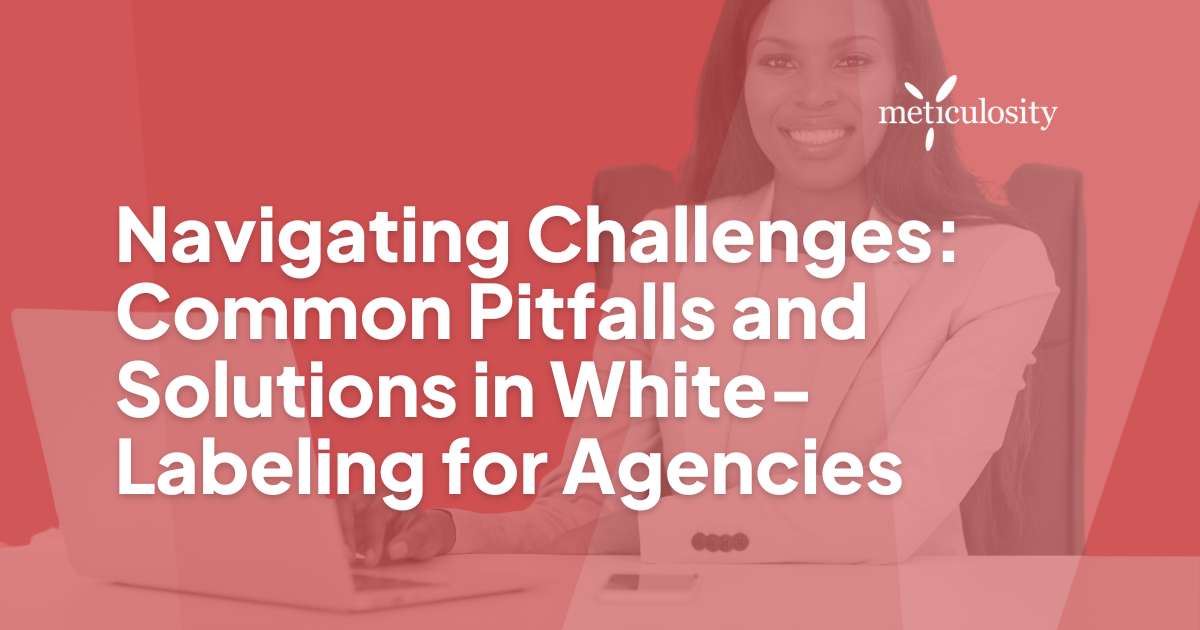Do you feel like navigating the white-labeling landscape for your agency is an uphill battle? You're not alone. A staggering 70% of marketers echo that sentiment, pinpointing partnership selection as a major stumbling block.
After diving headfirst into extensive research, we've surfaced with practical insights designed to steer clear of common pitfalls and pivot toward effective white-label strategies.
Key Takeaways
- To avoid problems, we must do our homework on what clients want and make sure there's enough demand for the services we offer.
- We need to keep client information secret and safe from people who might steal ideas or cause trouble.
- If things go wrong with white-labeling—like not enough people want the service, clients aren't happy, nobody talks clearly, or technology breaks—it's important to find out why and fix it fast.
- By doing good market research, making sure lots of people want what we're selling, talking openly with clients, using strong technology tools, and giving great help and support—we can make more money while keeping our brand looking good.
Looking to empower your agency? You can learn more here.
Definition & Benefits of White-Labeling for Agencies
White-labeling is when you take a product or service made by someone else and put your agency's name on it. It's like selling something that another company created but under your brand.
This way, customers think it comes from you. White-labeling is great because it saves the time and money that you would spend making your products.
Your agency gets lots of perks from white-labeling. You can offer more things to clients without having to be experts in creating every single one. It makes you look skilled because you give clients all kinds of services.
Also, your brand gets stronger as people see your name on good products and services they love using. Plus, you make more money since you sell these products at prices you set yourself.
Common Pitfalls in White-Labeling
Lack of market research, insufficient demand, client dissatisfaction, communication issues, and technical problems are common pitfalls in white-labeling. Learn how to navigate these challenges for successful agency white-labeling.
Lack of Market Research
Before jumping into white-labeling, you need to know what your potential customers want. If you don't look at the market closely, you might offer services that no one is looking for. This could waste your time and money.
It's like starting a journey without a map; chances are, you'll get lost along the way.
To avoid these mistakes, doing homework on trends and demands is key. Learning about what services are hot and what's not helps you create offers that sell. After all, knowing the terrain ensures a smoother ride toward business success.
Now, let's consider another common issue: insufficient demand.
Insufficient Demand
Insufficient demand can be a major pitfall for agencies involved in white-labeling. When there isn't enough demand for the services being offered, it can lead to underutilized resources and decreased revenue.
To address this challenge, conducting thorough market research becomes crucial. By identifying and analyzing the specific needs and demands of the target audience, agencies can tailor their services to meet those requirements effectively.
By understanding market needs and ensuring strong demand for services, agencies can position themselves as valuable partners to businesses seeking white-labeled solutions that align with their goals and objectives.
This proactive approach helps address insufficient demand and sets the stage for sustainable growth and success in white-labeling initiatives.
Client Dissatisfaction
Insufficient demand can lead to client dissatisfaction and challenges for agencies. It's important to understand the needs and expectations of clients before offering white-labeled services.
Clients may be dissatisfied if the services provided do not meet their specific requirements or fail to deliver the expected results, leading to a loss of trust and potential long-term business relationships.
To address client dissatisfaction, agencies should prioritize open communication with clients, actively seeking feedback, and making necessary adjustments to meet their evolving needs.
Communication Issues
Communication issues can quickly derail a white-labeling partnership. It's crucial to maintain open, honest, and transparent communication channels at all times. Regular updates on project progress and any challenges that arise are essential for building trust and ensuring the success of the collaboration.
Providing clear guidelines and expectations upfront can help avoid misunderstandings down the line. Utilizing tools for efficient communication and establishing designated points of contact can streamline interactions and prevent confusion.
Maintaining communication is key to navigating through these challenges effectively. Keeping everyone informed every step of the way ensures that issues are addressed promptly, leading to smoother operations and strengthened partnerships between agencies.
Technical Problems
Technical problems can cause significant challenges in white-labeling for agencies. Issues such as software bugs, integration complexities, or system downtime can lead to delays and disruptions in delivering services to clients.
These technical hiccups may also impact the quality of work and create dissatisfaction among clients. To overcome these challenges, investing in reliable technology solutions is crucial to ensure seamless operations and high-quality service delivery.
Agencies can mitigate technical risks by prioritizing innovation, expertise, and customization in technological implementations while enhancing their white-labeling capabilities.
Now, let's dive into the proactive measures to address these technical issues effectively.

Solutions for White-Labeling Challenges
Ensure thorough market research, strong demand for services, transparent communication, reliable technology utilization, and quality service and support.
Conduct Thorough Market Research
To ensure the success of white-labeling, conducting thorough market research is crucial. Understanding the needs and preferences of your target audience enables you to tailor your services effectively.
By analyzing market trends and consumer behavior, you can identify opportunities for growth and potential challenges to anticipate. This targeted approach allows you to refine your offerings, ensuring that they align with what clients are seeking and differentiate your agency in a competitive market.
Thorough market research equips you with valuable insights that inform strategic decision-making, enabling you to stay ahead of industry shifts and evolving client demands.
Ensure Strong Demand for Services
To ensure strong demand for services, thorough market research is crucial. Understanding the needs and trends in your target market helps identify where there's a gap that your white-labeled services can fill.
Maintaining transparent communication with clients also plays a vital role. By clearly conveying the value and benefits of your white-labeled offerings, you can help potential clients recognize the demand for these services.
Reliable technology should be utilized to deliver quality services efficiently while providing necessary support. This combination enhances the reputation of both your agency and your client's brand, paving the way for increased demand and stronger client relationships.
Maintain Transparent Communication
Transparent communication is crucial in white-labeling. All parties need to be open and honest about expectations, challenges, and progress. This helps in building trust and preventing misunderstandings.
Clear communication also ensures that everyone is on the same page, reducing the risk of errors or delays.
Being transparent means sharing information openly and promptly. It involves providing updates, addressing concerns, and seeking feedback throughout the white-labeling process. This fosters a collaborative environment where both the agency and its clients can work together effectively toward mutual success.
Utilize Reliable Technology
Reliable technology is crucial for successful white-labeling. By using dependable systems and tools, we ensure seamless service delivery to clients. Robust technology enhances efficiency and boosts scalability, enabling us to meet increasing demands effectively.
Additionally, utilizing reliable technology allows for flexibility in customizing solutions while maintaining the quality and confidentiality expected by our clients.
Moving forward to the next point on the agenda: "Provide Quality Services and Support." Let's dive into how these aspects contribute significantly to a successful white-labeling strategy.
Provide Quality Services and Support
To excel in white-labeling, offering top-notch services and unwavering support is crucial. This means delivering solutions that meet the highest standards, tailored to clients' specific needs.
As a marketer or business professional, ensuring quality is fundamental for building trust and credibility with your clients. It involves maintaining open lines of communication, addressing concerns promptly, and consistently striving for excellence in all aspects of service delivery.
By prioritizing quality services and robust support systems, you meet your client’s expectations and position your agency as a reliable and reputable partner.
Benefits of White-Labeling for Agencies
White-labeling allows agencies to increase efficiency, revenue, and client relationships while expanding their services and enhancing their branding. Want to learn more about how white-labeling can benefit your agency? Keep reading!
Increased Efficiency & Revenue
White-labeling can increase efficiency and revenue for agencies. It allows you to focus on your core competencies while relying on specialized expertise from white-label partners. This streamlines operations, reduces overhead costs, and enables you to scale services without the added burden of hiring and training new staff.
By leveraging white-labeling, agencies can expand their service offerings without significant investment in additional resources. This agility opens up opportunities to cater to a wider client base, tap into new markets, and ultimately drive revenue growth.
The flexibility offered by white-labeling empowers agencies to deliver high-quality solutions cost-effectively, enhancing overall operational efficiency and financial performance.
Stronger Client Relationships
White-labeling can help agencies build stronger client relationships by allowing them to offer a wider range of services without the need for additional resources. This can lead to increased client satisfaction and loyalty and opportunities for cross-selling and upselling.
By delivering high-quality white-labeled services, agencies can position themselves as reliable partners that consistently meet their client's needs, fostering trust and long-term relationships.
Taking advantage of white-labeling also enables agencies to focus on their core competencies while still meeting diverse client demands. Through this approach, agencies can show they are committed to addressing their client’s specific requirements, ultimately strengthening the bond between agency and client.
Expansion of Services Offered
Expanding services offered through white-labeling allows agencies to diversify their offerings and cater to a broader client base. By leveraging the expertise of specialized partners, agencies can provide a more comprehensive range of solutions without needing to develop them in-house.
This broadens the agency's portfolio and enables them to address a wider spectrum of client needs, positioning them as versatile and adaptable players in the market.
Capitalizing on the strengths of external partners empowers agencies to deliver an expanded suite of high-quality services that resonate with diverse client demands, ultimately enhancing their competitive edge and business growth.
Enhanced Reputation & Branding
Enhanced Reputation and branding a critical benefits of white-labeling for agencies. By offering top-notch services under their brand, agencies can bolster their reputation as industry leaders with expertise and reliability.
This enhances client trust and elevates the agency's brand image in the market, paving the way for increased visibility and credibility among potential clients. The seamless delivery of high-quality white-labeled services further solidifies the agency's position as an authoritative partner, expanding its reach and appeal to a wider audience.
Expanding service offerings through white-labeling allows agencies to showcase versatility and proficiency, positioning them as comprehensive solution providers in their respective fields.

Conclusion
In conclusion, white-labeling for agencies offers great benefits but comes with common pitfalls. However, agencies can enhance their reputation and revenue by addressing challenges like market research and client satisfaction with transparent communication and reliable technology.
Embracing the solutions can help agencies build stronger client relationships and expand their service offerings while successfully navigating the complexities of white-labeling.
Click here to learn more about agency marketing.
FAQs
1. What are common challenges agencies face when implementing white-label services, and how can they navigate them successfully?
-
- Quality Control: Maintaining consistent quality across white-labeled services.
- Communication Issues: Challenges in communication between the agency and white-label partners.
- Client Perception: Managing client perception when outsourcing services.
2. How can agencies ensure consistent quality when outsourcing services through white-label partnerships?
-
- Clear Guidelines: Establish clear guidelines and standards for service delivery with white-label partners.
- Regular Audits: Conduct regular audits and performance assessments to ensure adherence to quality standards.
- Feedback Loops: Implement feedback loops for continuous improvement in service quality.
3. How can agencies address communication challenges with white-label partners and ensure smooth collaboration?
-
- Clear Communication Channels: Establish clear communication channels and protocols between the agency and white-label partners.
- Regular Meetings: Schedule regular meetings to discuss ongoing projects, address concerns, and foster a collaborative environment.
- Project Management Tools: Utilize project management tools for transparent and efficient communication.
4. How can agencies manage client perception and maintain a positive image when outsourcing services through white-label arrangements?
-
- Transparent Communication: Maintain transparent communication with clients about the use of white-label services.
- Emphasize Expertise: Highlight the specialized expertise of white-label partners to assure clients of the quality of outsourced services.
- Client Education: Educate clients on the benefits of white-labeling in terms of efficiency, scalability, and access to specialized skills.
Successfully navigating challenges in white-labeling involves implementing strategies for quality control, addressing communication issues, and managing client perception to ensure a positive client-agency relationship.







